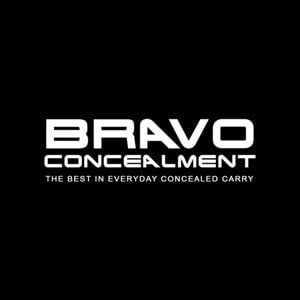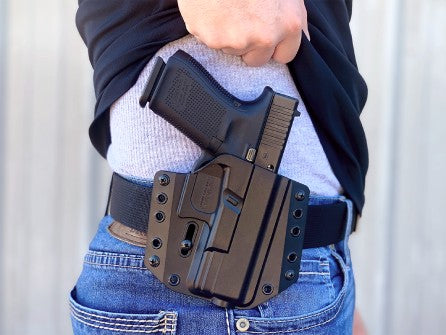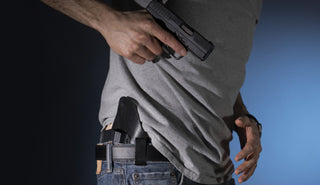
Compensated carry guns have a big presence in the market. Are they a good idea for concealed carry?
Springfield Armory’s wildly popular Hellcat was perhaps the first to offer a compensated option for their micro-compact. As is typical in the gun industry, it wasn’t long before most major manufacturers added this choice to their product lineup. A compensated barrel, or slide with it built in, such as SIG Sauer is doing on its 365 variant, offers definite gains for the shooting experience but carries potential pitfalls. This article examines both.
What is a compensator?

A compensator is a muzzle device that screws onto the exit end of the barrel. Somewhere there’s probably a compensated revolver, but for purposes of this discussion I’m referring to semi-auto pistols. The device is generally made of treated steel or an alloy, as it must be heat-tolerant. Most are designed to match the shape of the slide and are thus squarish, with rounded corners. The top and sides of this screw-on cube are vented. The number and angle of vents varies between models.
A small, polymer-frame pistol, even in 9 mm, has significant felt recoil. The shooter’s hands, wrists, and arms take up the physical push-back of a bullet that is propelled forward by about 48,000 pounds per square inch of pressure (for 9 mm) that’s present for a fleeting moment as the bullet travels down the barrel.
The bit of weight a compensator adds, along with the vents, work together to redirect the gas that leaves the muzzle as soon as the bullet leaves the muzzle, AKA recoil. Normally, muzzle rise, also called muzzle flip, is the result of recoil as the shooter’s wrists inescapably bend somewhat with the recoil impulse. The vents of a compensator offer reduction of that motion as gas escapes from the top and sides but is blocked at the bottom. The effectively reduces the energy transferred to the shooter.
Compensator Advantages

Logic follows that less felt recoil is better. There are both physical and practical reasons to have a compensator.
Shooters who fire their EDC gun regularly, especially for high-round count practice, will experience less physical fatigue as they have an easier job with a compensated barrel. The avoidance of repetitive strain injuries and the ability to protect existing injuries from worsening is a real physical advantage.
Practically speaking, compensators offer the ability to shorten the follow through phase of the firing sequence. When the muzzle rises less, sights settle back onto target faster, and the operator can, theoretically at least, put more rounds on target in the same time as he or she could without a compensated gun. This is an advantage that requires solid competence in the shooting fundamentals to enjoy. It’s also the major selling point of compensators, and one that few people really use, either lacking established fundamentals or lack of time spent in live fire with their micro compact.
Compensator Disadvantages
The advantage of less perceived recoil is one that is always present with a compensated gun. Under some conditions, disadvantages can arise. As I see them, they are as follows.
Reliability is critical for a gun that’s carried to preserve life. It’s possible that an encounter involving deadly force might involve shooting a human or predatory animal at very close range. More often than not, I have seen compensated guns fail to correctly cycle when the muzzle is within about a foot of the target. Semi-autos are precisely constructed for specific pressures to force the slide to cycle, exposing the ejection port, and picking up a new round from the magazine to be pushed into battery. Objects in close proximity in front of the muzzle at the moment of firing create refractory pressure back toward the slide that slows this cycle. The result is a misfeed that, in practice, is inconvenient and offers a chance to practice clearing a malfunction. In an actual act of defense, it effectively defeats the gun until that malfunction is cleared. Most such attacks, once underway, require more than one round to resolve. The potential negative outcomes of this are something you can imagine for yourself.
Likewise in close-quarters situations, such as shooting from inside a car, the shooter can experience more heat than they bargained for, usually on the support hand or arm. This is a minor consequence for most people, but can put off timid shooters, who are often the very ones for whom a compensated gun is recommended.
The other downside, to my mind, is the inconvenience of cleaning the compensator and barrel. Most polymer-lower pistols today provide the advantage of quick and easy field stripping and reassembly. Having a compensator means the system will gum up with carbon faster than a non-compensated gun, and a full field strip requires using a leverage tool to remove the device as it blocks easy removal of the slide and barrel, and recoil spring assembly. Some gun owners enjoy such tinkering. I’m not one of them.
Holster fit and ease of concealment are also potential disadvantages. A greater number of gun holster companies are making extended or open-bottom holsters that accommodate pistols that carry muzzle devices, but those are still the exception. And common sense says that having a bulkier gun makes concealing it more challenging.
It’s Personal
This article and my take on handguns in general, comes from the viewpoint that there is no trend or desirable gadget that’s more important than the gun functioning reliably. If you and I were shopping for a gun together for your own self-protection, I’d most likely share my opinion with you that it’s not worth risking the gun not working in a bad-breath distance attack. But there are some people whose injury history may force a different priority, and I respect that. Others may simply want to have the latest trend in gadgetry. While I don’t personally share that priority, it’s your money, and my local gun seller needs to stay in business.
Compensators are hot stuff right now. If you own one on your sub- or micro-compact semi and enjoy advantages I haven’t cited here, please tell us in the comments. In the meantime, shoot straight.







Leave a comment
1 comment
As far as compensated revolvers go, although not technically a comp, magna-port has been reducing muzzle rise via their ports forever. Also S&W offered some ported 686’s as well as large bore compensated revolvers. 🇺🇸👮🏻♂️👍🏻